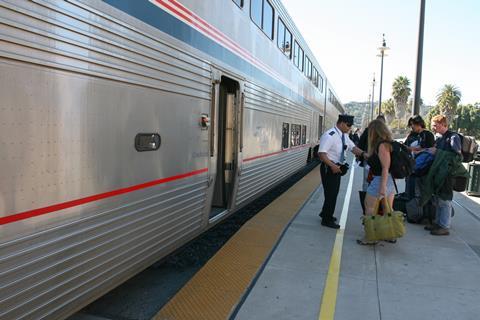
USA: Funding and safety legislation primarily benefiting Amtrak and other public transport operators received its final Congressional approval on October 1 with a veto-proof 74-24 majority which means President George Bush must sign the bill despite his administration’s general antagonism toward rail transit and long opposition to federal subsidies for inter-city passenger services.
Transportation Secretary Mary Peters said the administration ‘remains committed to working with Congress to implement meaningful changes to improve the performance of our inter-city passenger rail system’, adding that ‘our passenger rail system should be driven by sound economics’.
The legislation provides around $13bn over five years for Amtrak, which is double the annual amount it has received since the last long-range authorisation bill expired six years ago. However, the funding is still dependent upon a separate appropriation by Congress each year. The money will help to fund essential infrastructure renewals, especially in the Washington – New York – Boston Northeast Corridor, and the repair and improvement of the railway’s ageing car fleet. A long-dormant programme to develop a new generation of standard rolling stock, including a commuter rail variant, can also begin.
Other provisions are intended to encourage private-sector participation in the development of a high speed line in the Northeast Corridor and call for management reforms including a new board of directors, improved accounting and financial planning, and new standards for reliability and on-time performance.
Following the recent fatal crash in Los Angeles, the safety aspects of the legislation have been strengthened, with a section added requiring Positive Train Control to be installed on passenger and commuter routes by December 31 2015, together with main lines used to transport specified hazardous chemicals. The bill authorises $250m in federal grants to support the installation of PTC and other technologies such as ECP braking. Describing the PTC schedule as ‘aggressive’, AAR President & CEO Edward R Hamberger said ‘the scope of the work remaining to be accomplished presents a challenge to both the supply industry and the railroads.’
Another safety provision addresses the thorny issue of train crew fatigue. The bill requires longer uninterrupted rest periods of at least 10 h between shifts for freight train crews, limiting the maximum shift to 12 h and capping the number of working hours per month to 276, compared to the current limit of 400 h. The Department of Transportation is instructed to develop similar anti-fatigue parameters for passenger train crews.
The bill requires all major carriers to develop risk-based safety programmes to help prevent deaths and injuries, mandates further level crossing safety improvements, and authorises the Federal Railroad Administration to recruit another 200 inspectors.
Finally, the bill contains a $1·5bn earmark for the Washington Metropolitan Area Transit Authority, to help finance a massive renewal programme for both infrastructure and rolling stock. General Manager John Catoe says WMATA needs to spend $11·3bn on capital improvements between 2010 and 2020, including $7bn for repairs and $3·5bn to keep up with ridership growth. Noting that ‘we need to prioritise what gets fixed first’, he pointed out that the metro needs to replace one-third of its car fleet, about 300 vehicles, which are more than 30 years old.
















